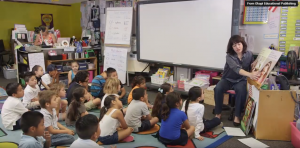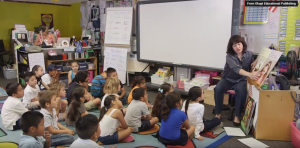
As Don Holdaway (1979) believed when he designed the instructional approach we know as Shared Reading, “children who are not thoroughly familiar with the syntactic patterns, idioms and tunes” of language “require the joyful repetition of rich literature.” This repetition of language, “through the ear and across the tongue,” embeds the patterns of book dialect within “the automatic language system of the child.” In other words, repetition of rich literature within a Shared Reading setting supports our young learners’ language development. This language, in turn, empowers these learners to become strong meaning-makers. Shared Reading is an indispensable instructional approach for our learners.
What Are Repeated Readings?
Shared Reading supports children to develop and expand language when teachers use familiar books. Texts for Shared Reading are designed to be read again and again, with the multiple exposures occurring over time. Books become more and more familiar with each revisit. Children co-construct ever-deepening meanings for these familiar mentor texts. In a fiction text, for example, students develop understandings about storylines and characters and the ways that stories are structured. In nonfiction texts, they discuss and process the ideas and information the author has shared, noticing the ways the messages are communicated in diagrams and other graphics. Within the Shared Reading approach, students learn vocabulary, phrasings, and expressions that signify meaning. As children deepen their understandings, they develop the ability to read the text for themselves. All these understandings come from texts used in multiple Shared Reading sessions.
What Is the Purpose of Different Shared Reading Sessions?
First Readings
On the first reading of a book, teachers include an introduction to the book and focus on general meanings. In the first read, the teacher reads the text to the students. Usually, in a first reading, the teacher would not point to or track the print because the focus is at the text level, not the print level. Some books require more than one first reading for children to understand the text.
In quality Shared Reading texts designed for emergent and early readers, the illustrations are multi-layered. In this first reading, a teacher should pause on pages, either before or after reading the words, to offer students time and opportunity to study illustrations.
Discussion during a first read usually occurs after the whole text has been read, especially if the text has rhyme, rhythm, and repetition or some type of pattern. By not stopping during this first read, the teacher invites students to notice rhyme, rhythm, and repetitive language or patterns. This is one difference between a text used in Read Aloud and those created for use in Shared Reading. In read aloud texts such as Chrysanthemum or Where the Wild Things Are, teachers and students stop along the way to discuss the text. Stopping during reading the text for discussion is crucial to supporting students to co-construct the meaning of these texts. But, when a text has rhyme, rhythm, repetition, or other patterns that support meaning-making, stopping during the first reading can interfere with students engaging with these text elements. These elements support students to take on more of the reading and eventually to read the text independently for themselves.
Second Readings
In the second readings, children are invited to join in the oral reading of the text as they feel comfortable. During these readings, teachers may use oral cloze in places, pausing and withdrawing their voice so children join in on repetitive or interesting places.
In the second readings, discussion occurs during the reading; teachers and students stop to discuss particular ideas within the text. This discussion can include talking in partnership and discussing in the whole group. The second readings offer an opportunity to make deeper meanings, to study more vocabulary, and to draw attention to text or language structures.
Again, second readings may mean multiple readings for the book to become familiar enough to return to the book for more specific focuses. In the second readings, teachers usually track the print with a pointer to draw attention to the print.
Returning to the Book
Returning to the book occurs once the text is well-known. When the text is familiar, the teacher can revisit for any number of focuses. Some of these revisits may occur in the same week as the first and second readings of the book. Others may occur later in the school year, depending on the needs of the students. This supports teachers to demonstrate skills and strategies in context as needed, using the same book for multiple purposes across the school year.
Some possible Return to the Book opportunities in Shared Reading might focus on:
- Letters, sounds, and words
- Fluency, print concepts, or extending oral language
- Responding to reading by writing about the text
- Revisiting the text with an audio reading
- Dramatizing the text to support rereading with fluency
- Creating innovations on texts to emphasize text structures, language patterns, and phonics work
Using Shared Reading texts over time is a powerful way to demonstrate skills and strategies in context AND develop the language for meaning-making.
Watch here how consultant Debra Crouch uses a Shared Reading text over several days with students.
Click here for The Shared Reading Approach Infographic.

